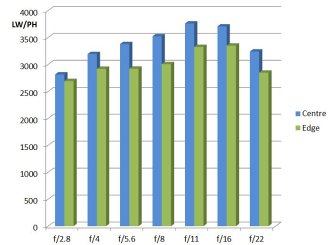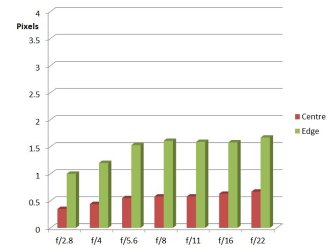Samyang AF 14mm f/2.8 ED FE Lens Review
Samyang AF 14mm f/2.8 ED AS IF UMC Performance
The lens returns an excellent set of figures, showing a very high level of sharpness. Images look crisp.
Centrally, sharpness is already very good at f/2.8 and f/4 and reaches an excellent level from f/5.6 through to f/16. It remains very good even at f/22.
The edges are very good from f/2.8 to f/8, excellent at f/11 and f/16 and very good at f/22. This is especially pleasing for an ultra-wide lens, resulting in a very even crispness from centre to edge.
How to read our charts
The blue column represents readings from the centre of the picture frame at the various apertures and the green is from the edges.The scale on the left side is an indication of actual image resolution as LW/PH and is described in detail above. The taller the column, the better the lens performance.
For this review, the lens was tested on a Sony Alpha A7R II using Imatest.
CA (Chromatic Aberration) is highly corrected and the results are impressive, especially for such a wide lens. In most images there is no intrusive CA even at the edges. It can be seen, but is creditably well corrected. If required, any residual CA can of course be removed in software.
How to read our charts
Chromatic aberration is the lens' inability to focus on the sensor or film all colours of visible light at the same point. Severe chromatic aberration gives a noticeable fringing or a halo effect around sharp edges within the picture. It can be cured in software.Apochromatic lenses have special lens elements (aspheric, extra-low dispersion etc) to minimize the problem, hence they usually cost more.
For this review, the lens was tested on a Sony Alpha A7R II using Imatest.
The quality of design and the lens coatings result in a very clean image even against the light. Flare does not intrude and has little effect either in terms of loss of contrast or the creation of image artefacts.
Barrel distortion, measuring at -3.66%, is very obvious. This is really to be expected and we have become used to seeing such distortion in very wide images. Pincushion distortion would not be visually tolerated in the same way. In many situations, even some architecture, the barrel distortion could perhaps be left in, but if needed then it can be easily removed in software.
Bokeh, the smoothness and quality of the out of focus areas, is probably less dramatic than with a telephoto lens, but is very satisfactory. Gradation is pleasant and the lens avoids any sign of a ragged transition from sharp to out of focus. For many applications an ultra-wide lens will be used at small apertures and here the depth of field is such that bokeh becomes a secondary issue. The lens does focus close enough that at wider apertures we can see some very attractive bokeh, which offers many creative possibilities.
Value For Money
The Samyang AF 50mm f/1.4 FE lens carries a price tag of £599. This compares to the Samyang 14mm f/2.8 ED AS IF UMC manual focus lens, which comes in at £299. However, the AF lens is a very different proposition and the benefits of AF are very considerable.
There are no real competitor lenses as such, the alternatives around this focal length being fish-eye lenses and/or APS-C format. If we look at how full frame DSLR marques fare, then Pentax have nothing in their range, Canon have the EF 14mm f/2.8 L II USM (£1599) and Nikon have the 14mm f/2.8 D AF ED (£1389).
Clearly this makes the new Samyang AF lens look very good value for money by comparison. For more options have a look at the Top 10 Best Samyang Lenses, or Top 15 Wide-angle Lenses.
Add your message
Please login here or if you've not registered, you can register here. Registering is safe, quick and free.
photodo Stats
428 MTF tests
74 in-depth photodo reviews
100+ users join each day
Help the lens community by reviewing or rating a lens today via our lens search
Latest Lens Reviews
- Chinon 28mm f/2.8 Vintage Lens Review
- Canon EF 70-200mm f/4L IS II USM Lens Review
- Samyang AF 85mm f/1.4 EF Review
- Sigma 70mm f/2.8 DG Macro Art Review
- Samyang AF 24mm f/2.8 FE Review
- Meike 50mm f/1.7 Review
- Tamron 70-210mm f/4 Di VC USD Review
- Lensbaby Burnside 35mm f/2.8 Review
- Asahi Super Takumar 50mm f/1.4 Review
- Asahi Super-Multi-Coated Takumar 135mm f/3.5 Review


